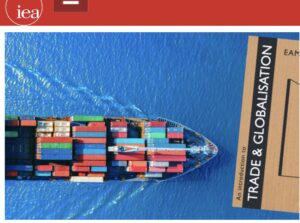Labor Mobility and Work Visas for Central Americans
Few avenues open for the impoverished majorities in Central America to pursue opportunity and prosperity. Young people are mobile and coming to the United States has been a difficult and often dangerous path. Economists make the case for labor mobility, of allowing people in poor countries opportunities to search for higher paying employment in wealthier countries.
Alternatively, higher paying work can be created (via investments) in Central American countries. That is, companies and individuals can deploy capital across Central America, creating better job opportunities. More on this below.
Donald Trump noted the importance of immigration in an October Wall Street Journal editorial board interview: “I want a lot of people to come in, but I want them to come in legally.” (Weekend Interview: Trump Tangles With the Journal’s Editors, WSJ (Oct. 18, 2024) Trump says he agrees with the WSJ editorial page on the benefits of immigration.
Though the news now focuses on H1B visas for high skill labor, low-skill workers matter as much or more. The “price” of barriers to labor mobility?
The average price equivalent of migration barriers in this setting for low-skill men is greater than $13,700 per worker per year. Natural and policy barriers may each create annual global losses of trillions of dollars. (The Place Premium: Bounding the Price Equivalent of Migration Barriers, Review of Economics and Statistics, 2019)
America needs immigrants, Trump said: “because we’re going to bring a lot of companies in through a combination of lower taxes where you build here and then we have to protect them with the tariffs. (Weekend Interview: Trump Tangles With the Journal’s Editors, WSJ (Oct. 18, 2024).
Nearly all economists (over centuries) believe higher tariffs will hurt the U.S. economy. For a discussion, see Eamonn Butler’s An Introduction to Trade and Globalization, online from the Institute for Economic Affairs.
Current and new tariffs also discourage the investment in Central America that would create more and better paying work there. Here is a 2022 Congressional Research Service review of the Dominican Republic-Central America-United States Free Trade Agreement (CAFTA-DR). Since signed in 2005, reduced trade barriers have increased trade between US and Central America. But the CAFTA-DR agreement has been criticized as both not enough and too much. An Investopedia overview notes labor union views:
It had many opponents. Among them, the AFL-CIO denounced the pact as “utterly devoid of compassion and opportunity for those who need it most–the 37 million Central Americans struggling in poverty and the millions of hard-working immigrants in this nation most vulnerable to layoffs and mistreatment.”
Why would the AFL-CIO, with 12.5 US members, be so concerned about the living conditions of 37 million workers in Central America? Lowering trade barriers would invite more investment, more capital, to flow to factories and other enterprises across Central American countries. Those workers and the products and services they provide would compete with factories where AFL-CIO members are employed in the U.S. So trade barriers can “protect” union jobs in the U.S.
Trade agreements like the CAFTA-DR include side-agreements regarding labor, environmental and other issues that may sound good on paper, but raise costs for companies wanting to export goods to the U.S.
With “top origin countries… El Salvador (741,000), Guatemala (724,000), and Honduras (490,000)” reports the Migration Policy Institute (MPI):
Many migrants from these countries have remained in the United States with Temporary Protected Status (TPS), which grants work authorization and relief from deportation. El Salvador, Honduras, and Nicaragua are among the 16 countries under TPS designations. As of November 2022, TPS protections covered approximately 190,900 Salvadorans, 57,600 Hondurans, and 3,100 Nicaraguans. Nationals of these three countries made up 47 percent of the 537,100 individuals with an approved TPS application.
MPI reports 55,300 Central American youths have DACA status (2022). And
In recent years, significant numbers of unaccompanied children from El Salvador, Guatemala, Honduras, and Nicaragua have arrived at the U.S.-Mexico border without authorization. These minors accounted for 75 percent of the total 222,000 CBP encounters of unaccompanied youth between October 2021 and March 2023. Overall, citizens of these four countries accounted for 28 percent of the more than 3.6 million encounters of irregularly arriving migrants at the U.S.-Mexico border in this period.
The NCFCA policy topic reads: The United States Federal Government should significantly reform its foreign policy toward one or more of the following Central American countries: Belize, Guatemala, Honduras, El Salvador, Nicaragua, and Costa Rica.
What are the populations of these listed Central American countries?
Belize: population: 415,789. Migration: About 16% of Belizeans live abroad, while immigrants constitute approximately 15% of Belize’s population. .. Median age: 26.8 GDP per person: $12,800 (2023 est.) (CIA World Factbook)
Guatemala: population: 18,255,216. Median age: 24.8 “Almost half of Guatemala’s population is under age 19” GDP per person: $12,700 (2023 est.)
Honduras, Population: 9,529,188. Median age: 25.7 years (2024 est.) GDP per person: $6,500 (2023 est.)
El Salvador, Population: 6,628,702, Median age: 29.7 years (2024 est.) GDP per person: $11,300 (2023 est.)
Nicaragua, Population: 6,676,948, GDP per person: 7,300 (2023 est.). Median age: 29 years (2024 est.)
Costa Rica. Population: 5,265,575, Median Age 35.5 years (2024 est.), GDP per person: $25,800 (2023 est.)
Perhaps too long a post already, but the obvious way to reduce migration from Central American countries to the United State is to improve economic opportunities across these countries
The ATLAS NETWORK Initiatives for Latin America offers a valuable overview or reforms.
Many past posts have focused on labor mobility as an alternative to the politically charged immigration debate. Few Central Americans want to spend the winter in Detroit or Cleveland, or even Seattle. Instead they are eager to earn good money providing valuable services, then to return home to their families (and warmer weather).
Past posts:
• Policy Resolutions: Immigration, FDA, Energy Policy
• No Better Foreign Aid than Labor Mobility to Help U.S. or E.U. Economy
• Legal Immigration, Freedom of Movement, and National Sovereignty

